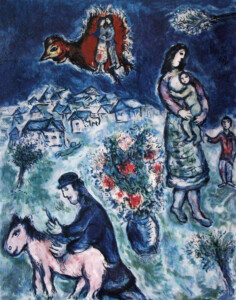TIOH Art Tour: On the Village Road

- By Marc Chagall
- Lithograph
- Signed in plate left to right
- Donated by Naomi and David Finkelstein
On the Village Road is a friendly, almost child-like image by Marc Chagall, but with much complexity beneath the surface. Marc Chagall was born in 1887 in Vitebsk, Belarus. He grew up in poverty and lived to see his culture, his people, and his country utterly destroyed during World War II. He lived in France for much of his life and became part of the artistic movements of Fauvism and Cubism. He is considered one of the most important modernist artists of the 20th century, and his work is known for its vibrant colors, dreamlike imagery, and Jewish themes.
Chagall is full of contradictions. The world he paints no longer exists, but in his dreams, it is still there. Chagall is a western artist but depicts eastern mythology. His art is deeply connected to Judaism, but he wasn’t particularly observant himself. His work is very Jewish, but not necessarily religious. It’s spiritual more than anything else. We usually think of Chagall as a painter of dreams.
Chagall paints the world of his childhood – the world of the old shtetls (villages), of poverty, of people working hard and having only limited options. In On the Village Road, the top half of the image is dominated by an indigo blue, which reminds us perhaps of the night and the dreams that he paints. But there is no darkness in the foreground and all the figures are clearly visible. While not a unified scene, there are several individual characters placed around the scene and moving within it.
In the center of the image, we see a bouquet of flowers, suggesting that there might be something to celebrate. At the bottom left we see a Jewish man shearing a goat. Above his head, almost invisible, we see a faint transparent figure floating back to the shtetl, as in a dream, as if liberated from daily work. Above the shtetl, we see a very peculiar scene – in the middle of the dreamy night sky are two figures embracing atop a flying bird. They are no longer part of our world, part of the harsh life of the village. They are liberated in an embrace of love. On the right-hand side we see a woman with a young child and an older child standing next to her. She’s lovingly holding the child and she seems perfectly happy, despite the harshness which we know permeated to the old shtetls. Perhaps the young boy on the right will finally grow up to become the man that we see in the bottom left taking his turn to shear the animals or perhaps we see his father in the bottom left. Who knows whether it is the cycle of life that we see, with the flowers in the center, or just the man and the husband dreaming of what might have been, what could have been, or how they once started, or how they longed to be back together at the end of the day after hard work. It’s always a dream.
Home